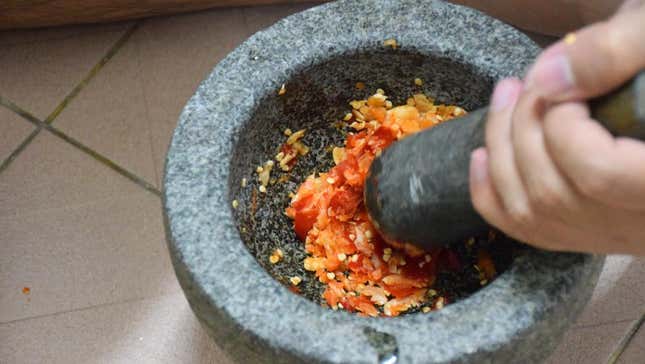
The chop, the dice, the slice, the julienne—cooking is filled with endless ways to prepare your ingredients. Most are functional, and some are just for show, but there are a myriad of terms and techniques you can learn as you work your way through recipe after recipe. A lot of the instruction in both cookbooks and online tutorials understandably focuses on knife work, but there’s one way of preparing ingredients that goes in the opposite direction, eschewing precision and appearance and focusing entirely on flavor. That method is the satisfyingly simple approach of just crushing the hell out of things.
Pounding or crushing ingredients can take a few different forms and commonly employs tools like a mortar and pestle or molcajete, the preferred method for many traditional dishes like guacamole. However, although the bowls look pretty on the shelves of Williams-Sonoma, the mortar and pestle’s association with manual labor seems at odds with the modern kitchen. Why grind spices by hand with a heavy handheld club when you can toss them in an electric spice grinder while you handle other prep tasks?
Why some ingredients need to be crushed
The reason pounding ingredients brings out more flavor is because you are more fully rupturing the cells in food that contain aromatic compounds and flavors. When you cut up something like garlic, even with the power of a tool like a food processor, you are only slicing open some of the microscopic structures that hold in flavor, but the more visceral practice of smashing the clove liberates almost all of that precious garlic taste from its cellular prison. In this great video on making pesto, J. Kenji López-Alt demonstrates this concept with, of all things, a stack of wet sponges.
Flavor extraction may be the most important factor in pounding food, yet equally important is the fact that it’s just way more fun. I’m not one to lament the decline in hands-on labor when a new electronic tool really can do the job faster and better, but sometimes it’s just nice to get back to some of those primal preparations. Crushing your ingredients over and over as they slowly meld into a fragrant, uniform paste is incredibly satisfying, and you can work out some of the day’s frustration in a tasty and productive way. Cooking can sometimes be an endless onslaught of chopping; it’s nice to let loose and pulverize an onion once in a while.
The best way to pound out your food
Crushing and pounding have the biggest impact when you’re preparing spices and other aromatic ingredients such as hot peppers and shallots. Using a mortar and pestle is transformative for dishes that rely heavily on spice pastes like curry, but even just pounding a simple addition of ginger into a paste can be a big upgrade to dishes that call for it.
Just be careful with how much aromatic power you are releasing. Even as someone who never cries from slicing onions and normally doesn’t struggle with chopping spicy ingredients, I’ve made the mistake of crushing a few too many serrano peppers at once, and it has left me weeping over the sink. Fortunately, that early mistake was also one that showed me just how potent pounding can be.
Do more crushing, pounding, and smashing as you cook
The extra time it takes to do this manually is well worth it. Pesto is traditionally prepared with a mortar and pestle, with grinding and crushing actions squeezing far more flavor out of the basil and pine nuts than you ever thought possible. I thought I had my homemade guacamole down pat for years, yet one round of smashing avocados made me realize the old ways really are best. Mediterranean and Middle Eastern dips are also great showcases for a mortar and pestle: Hummus, muhammara, and baba ghanoush are all going to be more flavorful when you sacrifice the convenience of a food processor for the physicality of a few minutes of smashing.
I could expound on the wonders of crushing the various elements of salsa or chimichurri, but you get the point. You might, very reasonably, resist adding another object to your kitchen counter, but consider that archaeologists have discovered mortar and pestles that are more than 30,000 years old—clearly, crushing food is essential to our enjoyment of it. Those smells wafting from the bowls told our ancestors they were doing something right.
Have a good time crushing your food. It’s one old-fashioned way of doing things that’s never going to lose its value.